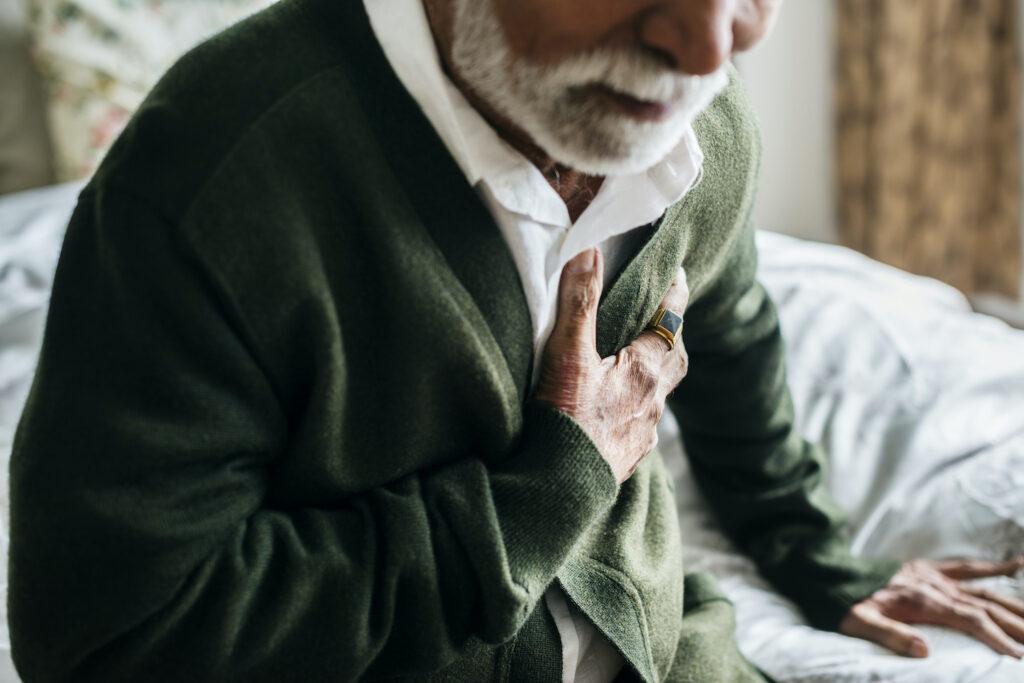
Sleep-disordered breathing and heart failure appear to have a bidirectional relationship.1 Obstructive sleep apnea is an independent risk factor to develop heart failure2. Of patients with known heart failure, most have sleep-disordered breathing (both reduced and normal ejection fraction3-5). Sleep-disordered breathing appears to adversely affect heart failure outcomes.6 This bidirectional relationship signifies importance of connection however until now the impact of sleep disordered breathing on heart failure prognosis has been unclear. . Fortunately, a recent meta-analysis provides some clarity.
TST90 predicts mortality in ambulatory heart failure patients
In May 2021, researchers at the University of Toronto presented the results of a systematic review and meta-analysis at the American College of Cardiology conference in Atlanta, GA.7 The authors screened more than 100,000 citations and identified 10 studies that included results of nearly 9,000 ambulatory heart failure patients. They reported that sleep-disordered breathing was not significantly associated with mortality or hospital admission. Likewise, apnea-hypopnea index, or AHI, was not significantly associated with mortality either. However, minutes spent under 90% oxygen saturation, also known as TST90, was significantly associated with mortality. This suggests TST90 may be able to identify which heart failure patients are at particular risk for premature mortality.
Implications for cardiology practice
These results reinforce previous findings that sleep-disordered breathing is a risk factor for death in ambulatory patients with heart failure. In the absence of additional studies, cardiologists can lean on quantitative measures of TST90 as a way to identify those at risk from a notoriously heterogeneous patient population.7 While additional work is needed, this metric may help cardiologists select which heart failure patients may benefit from CPAP or other sleep apnea treatments, a process that has proven difficult based on clinical trial results alone.8,9 At the very least, worsening sleep-disordered breathing parameters may indicate worsening heart failure,10,11 which would allow early heart failure treatment optimization prior to a full exacerbation with hospitalization. Of course, evaluation of TST90 and other sleep-disordered breathing indicators can be accomplished with unobtrusive, convenient, at-home sleep apnea testing and monitoring.
WatchPAT® provides convenient, at-home monitoring of TST90 and AHI
In-laboratory sleep apnea testing, i.e., polysomnography, is considered the gold standard for sleep-disordered breathing diagnosis; however, formal polysomnography is impractical for ongoing monitoring. Fortunately, at-home sleep apnea testing devices are now available which reliably correlate with in-laboratory polysomnography. WatchPAT® is an at-home sleep apnea testing device that detects peripheral arterial tone, heart rate, oximetry, actigraphy, body position, snoring, and chest motion through small, unobtrusive sensors worn on the wrist, chest, and finger. Clinical studies have shown that WatchPAT® testing achieves an 89% correlation with in-laboratory polysomnography.12 It provides instant, easy-to-interpret reporting of AHI, oxygen levels including desaturations (i.e., TST90), heart rate, sleep cycle, and body position information. The Central PLUS Module provides detailed information on central sleep apnea, which is particularly prevalent and problematic in patients with chronic heart failure. Perhaps most importantly, cardiologists can prescribe and implement this at-home sleep testing without a referral to a sleep center or sleep medicine specialist.
More research is needed, but cardiologists can act now
The full extent of the interactions between sleep-disordered breathing and heart failure is still unknown. Clearly, additional prospective studies are needed to determine the role of CPAP in the treatment of heart failure-related morbidity and mortality. Nonetheless, the adverse consequences of obstructive and central sleep apnea in people with heart failure are clear. If specific measures of sleep-disordered breathing severity can identify heart failure patients at particular risk for exacerbation or death, at-home sleep apnea testing is a convenient means for cardiologists to gather those clinical data.
References
1. Pietrock C, von Haehling S. Sleep‐disordered breathing in heart failure: facts and numbers. In: Wiley Online Library; 2017.
2. Shahar E, Whitney CW, Redline S, et al. Sleep-disordered breathing and cardiovascular disease: cross-sectional results of the Sleep Heart Health Study. Am J Respir Crit Care Med. 2001;163(1):19-25. 10.1164/ajrccm.163.1.2001008
3. Oldenburg O, Lamp B, Faber L, Teschler H, Horstkotte D, Topfer V. Sleep-disordered breathing in patients with symptomatic heart failure: a contemporary study of prevalence in and characteristics of 700 patients. Eur J Heart Fail. 2007;9(3):251-257. 10.1016/j.ejheart.2006.08.003
4. Sekizuka H, Osada N, Miyake F. Sleep disordered breathing in heart failure patients with reduced versus preserved ejection fraction. Heart Lung Circ. 2013;22(2):104-109. 10.1016/j.hlc.2012.08.006
5. Bitter T, Faber L, Hering D, Langer C, Horstkotte D, Oldenburg O. Sleep-disordered breathing in heart failure with normal left ventricular ejection fraction. Eur J Heart Fail. 2009;11(6):602-608. 10.1093/eurjhf/hfp057
6. Javaheri S, Shukla R, Zeigler H, Wexler L. Central sleep apnea, right ventricular dysfunction, and low diastolic blood pressure are predictors of mortality in systolic heart failure. J Am Coll Cardiol. 2007;49(20):2028-2034. 10.1016/j.jacc.2007.01.084
7. Sterling LH, Lalonde S, Alba AC. Sleep Disordered Breathing as a Predictor of Morbidity and Mortality in Ambulatory Patients with Heart Failure: A Systematic Review and Meta-Analysis. Journal of the American College of Cardiology. 2021;77(18):673-673. 10.1016/s0735-1097(21)02032-5
8. Cowie MR, Woehrle H, Wegscheider K, et al. Adaptive Servo-Ventilation for Central Sleep Apnea in Systolic Heart Failure. N Engl J Med. 2015;373(12):1095-1105. 10.1056/NEJMoa1506459
9. Bradley TD, Logan AG, Kimoff RJ, et al. Continuous positive airway pressure for central sleep apnea and heart failure. N Engl J Med. 2005;353(19):2025-2033. 10.1056/NEJMoa051001
10. McDonald K, O’Hanlon R, Savage HO, et al. Sleep-disordered breathing in chronic heart failure is highly variable when measured remotely using a novel non-contact biomotion sensor. European journal of heart failure. 2017;19(5):688-690.
11. Defaye P, de la Cruz I, Marti-Almor J, et al. A pacemaker transthoracic impedance sensor with an advanced algorithm to identify severe sleep apnea: the DREAM European study. Heart Rhythm. 2014;11(5):842-848. 10.1016/j.hrthm.2014.02.01112. Epstein M, Musa T, Chiu S, et al. Use of the WatchPAT to detect occult residual sleep-disordered breathing in patients on CPAP for obstructive sleep apnea. J Clin Sleep Med. 2020;16(7):1073-1080. 10.5664/jcsm.8406
